PHOTOS SECTION

Over the years, Jim Obergefell (bottom right), and his longtime partner, John Arthur (top), had talked about getting married, but Ohio’s voters banned same-sex marriage in 2004 and the federal government did not recognize state-sanctioned marriages among gay couples. Jim, who lost his mother while he was in college, grew close to John Arthur’s mother, Marilyn (bottom left). She was a frequent guest at their house located on a hillside overlooking Cincinnati’s Mill Creek Valley. John and Jim nicknamed the property the “Big House” and filled the rooms with work by local artists. (Courtesy of Jim Obergefell)

John Arthur (left) and his younger brother, Curtis, forged a close relationship early on. Years later, after John was diagnosed with ALS, Curtis left his job in Saudi Arabia and moved to Toronto to be closer to his brother. (Courtesy of Paulette Roberts)
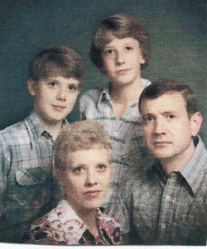
John (top center) and Curtis Arthur grew up in a turbulent home, and John fought frequently with their father, Chester (bottom right). When John started dating men, Curtis told Chester, “If you cut John out of your life, you’re going to cut me out, too.” (Courtesy of Paulette Roberts)

John Arthur’s favorite aunt, Paulette Roberts, loved John like her own from the moment he was born. In 1977, she took John (left), Curtis Arthur, her son Keith Cassidy (far right), and friend Nancy Cutler on a river rafting trip in West Virginia. (Courtesy of Paulette Roberts)

Two years after Jim Obergefell and John Arthur started living together, family and friends gathered at Chester Arthur’s house, and Jim was struck by the similarities between John and his father. From left to right: John Arthur’s uncle Mike Roberts, Curtis Arthur, longtime friend Meb Wolfe, Jim Obergefell, and Chester Arthur. (Courtesy of Paulette Roberts)

By 1995, John Arthur and his father, shown here at a family wedding, had formed an uneasy truce. “Well,” Chester Arthur would tell his son after the ALS diagnosis in 2011, “sometimes you’ve just got to play the hand that life deals you.” (Courtesy of Paulette Roberts)

Jim Obergefell and John Arthur fell in love in 1992 at a New Year’s Eve party at John’s house in Cincinnati, which they called the “Abbey.” Within weeks, Jim left graduate school and moved into the house with John. They posed for a picture there in 1993. (Courtesy of Jim Obergefell)

Jim Obergefell was a straight-A student in Sandusky, Ohio, the youngest of six siblings. His father, Arthur, worked in factories and manufacturing plants. His mother, Mary, was a librarian. In 1972, he dressed up with his parents for a rehearsal dinner for his brother’s wedding. (Courtesy of Jim Obergefell)

In the early 1990s, Al Gerhardstein had a growing civil rights legal practice in Cincinnati. Al and his wife, Mimi Gingold, took their children Ben (right), Adam (center) and Jessica to the First Unitarian Church, which would later honor Al for his work on gay rights. (Courtesy of the Gerhardstein and Gingold family)

Al Gerhardstein’s youngest child, Jessica, loved to go to her father’s office. Years later, Al told her, “You know, you might be frustrated if you’re on the sidelines and not able to engage directly in the systems that you want to change.” Jessica would one day decide to go to law school. (Courtesy of the Gerhardstein and Gingold family)

Jim and John loved to travel; in 2009 they took a Mediterranean cruise.

Three years earlier they traveled to Sweden. (Courtesy of Jim Obergefell)

In the months before John’s ALS diagnosis in 2011, Jim and John spent time in New York City, touring museums, seeing shows, and shopping. At home in Cincinnati, they had sold their large house, bought a condominium, and renovated every room. (Courtesy of Jim Obergefell)

In February 2014, Al Gerhardstein sued the State of Ohio on behalf of four gay couples, including Pam and Nicole Yorksmith (standing third and fourth from the right) and Joseph Vitale (seated in blue sweater) and Rob Talmas, who wanted to secure accurate birth certificates for their children. At a press conference in Cincinnati, Al (seated at microphone) said, “A family is a loving, nurturing group of people” and their children’s birth certificates “ought to be right.” (AP Images / Al Behrman)
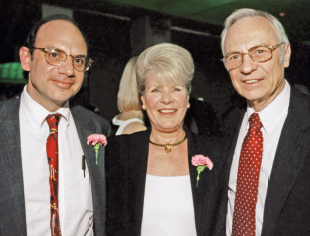
Al Gerhardstein (left), his law office manager Mary Armor (center) and his law partner Robert Laufman (right) at the annual Stonewall Cincinnati dinner in 2000. They spent years working together in a civil rights practice and were unafraid of taking on the most powerful local institutions, including the City of Cincinnati. (Courtesy of Mary Armor)

Jim Obergefell proposed to John Arthur on June 26, 2013, the day the U.S. Supreme Court issued an historic ruling that required the federal government to recognize state-sanctioned marriages among gay couples. Jim chartered a medical plane and flew with John to Maryland, where same-sex marriage was legal. John’s aunt Paulette Roberts (center) performed their marriage on a tarmac outside of Baltimore. (From The Cincinnati Enquirer, 2015-06-26 © 2015 Gannett-Community Publishing. All rights reserved.)

Newborn Cooper Talmas-Vitale. Husbands Rob Talmas and Joseph Vitale raced from their home in New York City to a hospital in Ohio in April 2013 to bring home their newly adopted son, Cooper. Months later, they discovered that the State of Ohio would only list one father’s name on his birth certificate, deeming the other a legal stranger.

Rob Talmas, Cooper Talmas-Vitale, and Joseph Vitale in front of the U.S. Supreme Court in April 2015, the day their lawyers argued for marriage equality in the name of more than thirty plaintiffs from four states, including Cooper. (Courtesy of the Talmas-Vitale family, bottom photo by Scott Fausett)
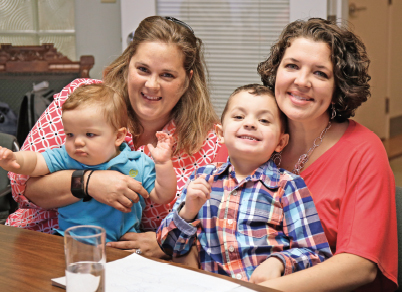
Pam Yorksmith (left) and her wife, Nicole (right), became Al Gerhardstein’s plaintiffs when they learned that the State of Ohio would only list Nicole’s name on the birth certificates for their two boys, Orion (left) and Grayden. “I do the four A.M. feedings,” Pam Yorksmith told her wife, “but I am always less than.” (AP Images / Gary Landers)
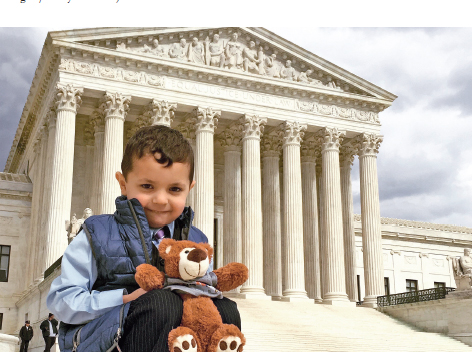
Grayden Yorksmith, four, sits on the steps of the U.S. Supreme Court the day before oral arguments in April 2015. His mothers had been married in California in 2008. In the hallway of their home, they kept a wall clock permanently set to 6:30 P.M. to commemorate the moment they exchanged wedding vows. (Courtesy of the Yorksmith family, photo by Vanessa Melendez)

Tennessee plaintiffs Sophy Jesty (left) and Val Tanco (right) stand with their lawyer, Regina Lambert (center), in front of the U.S. Supreme Court the day before oral arguments. Jesty and Tanco, married in New York, wanted to secure an accurate birth certificate for their daughter but the State of Tennessee would not recognize their marriage. (Courtesy of Regina Lambert)

Knoxville attorney Regina Lambert took her father, John Paul Lambert, to Cincinnati for a rally the day before the cases from Ohio, Tennessee, Kentucky, and Michigan were argued before the Sixth Circuit Court of Appeals. “It was initially difficult to accept that he had a gay child,” Lambert, who is gay, said later. “Fortunately, we worked things out early in my life and his love for me allowed his heart to change.” (Courtesy of Regina Lambert)

Isaiah De Leon, Greg Bourke, Michael De Leon, and Bella De Leon on a family spring break trip in 2014 to New York, where they toured the 9/11 Tribute Center. Kentucky plaintiffs Bourke and De Leon married in Niagara Falls in front of their adopted children in 2004. They led busy lives filled with church, soccer practices, and Boy Scout meetings, but got involved in the case so that both fathers could be named on their children’s birth certificates. (Courtesy of the De Leon and Bourke family)

Isaiah De Leon, Michael De Leon, Bella De Leon, and Greg Bourke waited for oral arguments to begin at the Sixth Circuit Court of Appeals in Cincinnati in August 2014. Plaintiffs from Kentucky, Ohio, Tennessee, and Michigan met for the first time and took turns passing around cell phones so that each family could get pictures on the historic day. (Courtesy of the De Leon and Bourke family)

Sixth Circuit Court of Appeals judge Martha Craig Daughtrey, one of three judges tasked with deciding the same-sex marriage cases, believed in the right to marriage equality and tried to convince the other two judges on the panel to vote with her. “These two men were in love,” she emphasized, speaking to her colleagues about Jim Obergefell and John Arthur. (John Partipilo / The Tennessean. From The Tennessean, 2015-03-26 © 2015 Gannett-Community Publishing. All rights reserved.)
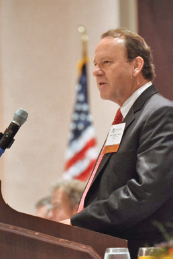
Early rulings by federal judge Timothy S. Black required the State of Ohio to recognize the marriages of gay couples. “The marriage ban,” he wrote, “embodies an unequivocal, purposeful and explicitly discriminatory classification, singling out same-sex couples alone, for disrespect of their out-of-state marriages and denial of their fundamental liberties.” (Courtesy of the Cincinnati Bar Association)

Sixth Circuit Court of Appeals judge Jeffrey Sutton, a leading conservative voice on the court, wrote the majority opinion ruling against the marriage plaintiffs from Ohio, Michigan, Kentucky, and Tennessee. “Not one of the plaintiff’s theories . . . makes the case for constitutionalizing the definition of marriage,” he wrote. This opinion would create a “split” among the nation’s circuit courts and push the case toward a final ruling by the U.S. Supreme court. (AP Images / Evan Vucci)

Just after the historic decision at the U.S. Supreme Court on June 26, 2015, Al Gerhardstein and Jim Obergefell linked arms outside the building, where hundreds of cheering supporters waited to greet them. (Doug Mills / The New York Times / Redux Pictures)

Veteran attorneys Mary Bonauto (center) and Doug Hallward-Driemeier (right) were the two chosen to argue before the Supreme Court in April 2015; here Bonauto addresses journalists after their appearance. (AP Images / Cliff Owen)

Jim Obergefell greets another noted marriage equality plaintiff, Edie Windsor, at an American Civil Liberties Union reception in New York City a month after the historic Obergefell v. Hodges ruling. Windsor’s case in 2013 forced the federal government to recognize state-sanctioned marriages among gay couples and provide all the federal benefits that come with marriage. It was on the day of the Windsor decision that Jim proposed to John Arthur.(Courtesy of Donna F. Aceto)

On the eve of oral arguments at the U.S. Supreme Court in April 2015, Isaiah De Leon listened to protesters make antigay declarations over a bullhorn. In response, he borrowed a rainbow flag and walked proudly past the protesters as his fathers watched. (Courtesy of the De Leon and Bourke family)

Jim Obergefell speaks in Philadelphia after the Supreme Court decision in 2015. With same-sex marriage a constitutional right in all fifty states, Obergefell turned to new frontiers in the gay rights movement, including the need for a federal anti-discrimination law. (AP Images / Matt Rourke)